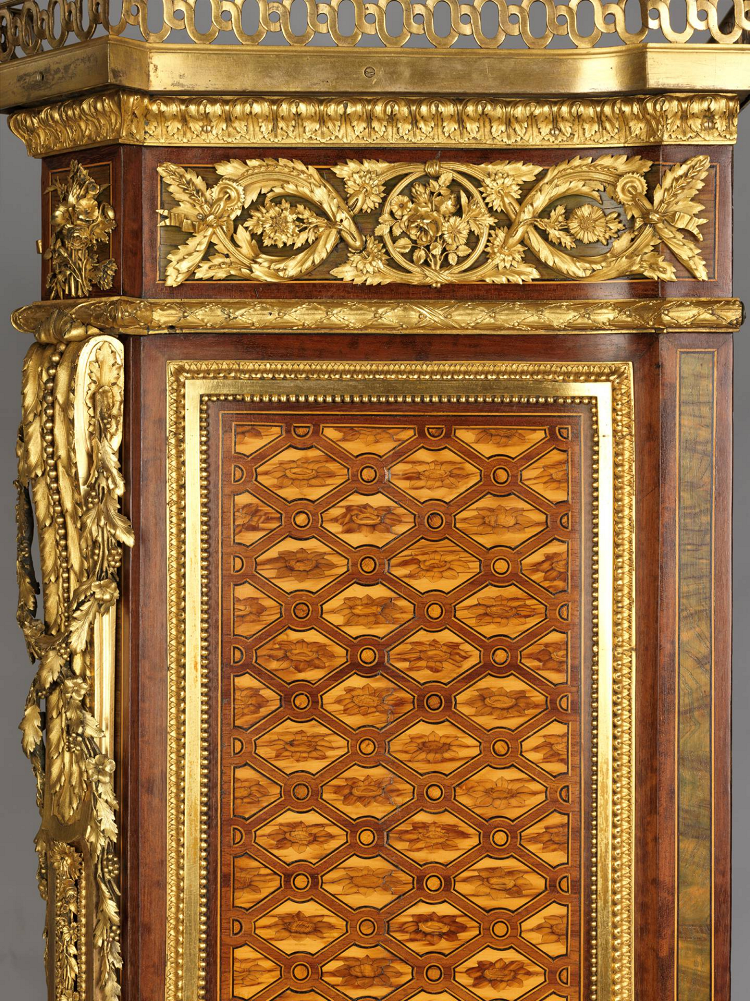 |
| The oval bronze plaque is a later replacement - possibly even done by Riesener, himself - for the original marquetry medallion. |
 |
| Like much of Riesener's work for Marie Antoinette, he has included her initials in the bronze doré frieze. |
*
*
 |
| With its original marquetry intact, this nearly identical commode - one of the three - is in the collection of Versailles. |
 |
| The commode is a feature of the restored décor of Marie Antoinette's cabinet intérieur or cabinet doré. |
*
Secrétaire à abattant. Marquetry removed and re-veneered and the central medallion added, circa 1794–1825. Materials: Oak, burr wood (probably yew), purplewood, stained woods, ebony or ebonized wood, box, gilt bronze, Carrara marble. Ordered for the queen's private rooms at the château de Marly, the desk and corner cabinet (along with a matching chest of drawers) were instead sent to Versailles in February 1783 and installed in her cabinet intérieur. They remained there less than a year before being sent to Marly as originally intended. But the queen rarely visited Marly and only three weeks later they were returned to Versailles where they were to be used in her new ground floor apartment.
*
Encoignure (corner cabinet), en suite with the above desk. Marquetry removed and re-veneered circa 1794–1825. Materials: Oak, burr wood (probably yew), purplewood, stained woods, ebony or ebonized wood, box, gilt bronze, Carrara marble.
*
*
Much of the marquetry decoration of eighteenth-century furniture was originally fairly colorful, a color that has faded markedly over time. A great variety of woods were used - their color both natural and dyed - and the combinations were chosen with consideration for the overall scheme of the settings for which the finished furniture was intended. This particular piece was specifically designed for its place in the queen's cabinet intérieur and it echoed the coloration of the newly-made embroidered silk wall hangings designed by Jacques Gondoin; the pastoral trophy at the center of the commode was created to match a similar passage in the wall fabric. Below is the Wallace Collection's imagined recreation/restoration of Riesener's commode in its original state, something which they based on traces of color that remain on the piece. While I believe that the color here may be just a bit more intense than it ever actually was, it's still a fascinating thing to ponder. Also something to ponder is whether the passage of time and the loss of all that color, like the loss of the polychrome of antique statuary and architecture, has been an improvement...?






































Hello!
ReplyDeleteWe have been absent from the Blogosphere for an age but, on our return, how thrilling to have discovered your blog.
The Wallace Collection holds so many wonderful treasures but this detailed look into the furniture designed for Marie Antoinette is a delight whilst we are all locked down and prohibited from visiting the galleries and museums that we have missed for too long.
It never fails to amaze one what wealth Marie Antoinette had at her disposal and the way in which she acted as a muse for so many artists of the day. Every detail of the furniture is so perfectly executed and o be able to live with such beautiful objects is privilege indeed.
Thank you for the tour.
Thank you so much, Jane-and-Lance! And thank you for the introduction to your very charming blog; so glad for its "reboot." I look forward to any further installment. : )
DeleteDelighted that you have chosen to follow us. Thank you.
Deleteevery single detail is just exquisite. Stunning!
ReplyDeleteThank you Steve for these pictures and the detailed explanations.
ReplyDeleteAlthough I always feel so sorry that some possibly rich people felt the need to 'enhance' such beautiful pieces of craftmanship with exaggerated signs of their unbalanced tastes.
However, I stick to what I told some know-it-all guy years ago at an antiques fair who was sententious like "ah! All these beautiful furnitures that were stolen by the English and the like who took advantage of the Revolution's disorders!" - (blah blah)
I couldn't help but answering something like: "Unless I' am proven wrong, all of these furnitures would have perished in flames or under the hammer of revolutionaries hatred if not salvaged by people of tastes from all over Europe who sent their stewards to buy the very finest of what France had to "offer."" (I may not have been that polite at the time)
So my heart goes to the educated people, whatever the times and no wonder the circumstances, who will always dedicate themselves -and their resources- to saving AND transmitting beauty throughout generations.
Cheers to them!
Laurent
Well said! : )
Delete